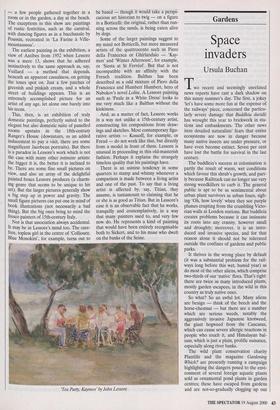Gardens
Space invaders
Ursula Buchan
Two recent and seemingly unrelated news reports have cast a dark shadow on this sunny summer's day. The first, a jokey `let's have some more fun at the expense of the railways' piece, concerned the particu- larly severe damage that Buddleia davidii has wrought this year to brickwork in sta- tions and embankments. The other news item detailed naturalists' fears that entire ecosystems are now in danger because many native insects are under pressure, or have even become extinct. Seven per cent have lost the battle for survival in the last century.
The buddleia's success at colonisation is partly the result of warm, wet conditions which favour this shrub's growth, and part- ly because Railtrack can no longer use very strong weedkillers to curb it. The general public is apt to be as sentimental about urban plant survivors as urban foxes, sigh- ing 'Oh, how lovely' when they see purple plumes erupting from the crumbling Victo- rian walls at London stations. But buddleia creates problems because it can insinuate its roots into any cranny, however small and droughty; moreover, it is an intro- duced and invasive species, and for that reason alone it should not be tolerated outside the confines of gardens and public parks.
It thrives in the wrong place by default (it was a substantial problem for the rail- ways long before this wet, humid year) as do most of the other aliens, which comprise two-thirds of our 'native' flora. That's right: there are twice as many introduced plants, mostly garden escapees, in the wild in this country as truly native ones.
So what? So an awful lot. Many aliens are benign — think of the beech and the horse-chestnut — but there are a number which are serious weeds, notably the aggressively invasive Japanese knotweed, the giant hogweed from the Caucasus, which can cause severe allergic reactions in people who touch it, and Himalayan bal- sam, which is just a plain, prolific nuisance, especially along river banks.
The wild plant conservation charity Plantlife and the magazine Gardening Which? are presently running a campaign highlighting the dangers posed to the envi- ronment of several foreign aquatic plants sold as ornamental pond plants in garden centres; these have escaped from gardens and are not-so-gradually clogging up our waterways and replacing native aquatics. The floating pennywort from America (Hydrocotyle ranunculoides) develops mats which expand by four inches a day, and is a problem in, for example, the Pevensey Lev- els in East Sussex; Parrot's feather, Myrio- phyllum aquaticum, is a Brazilian plant which grows a floating carpet sturdy enough to support a man and is quite wide- ly spread now in southern England, fos- tered by warm winters; and Crassula helmsii, the New Zealand pigmyweed, which has colonised five of the nine sites where the native starfruit grows. Tiny pieces of these plants can regenerate and rapidly form new colonies which crowd out better-behaved native plants and deprive fish and other creatures of oxygen. It has been estimated that the annual cost of treating contaminated aquatic habitats is L4-£5 million.
As for the disappearance or drop in numbers of so many native insects, the rea- sons cited range from loss of habitat due to building developments or farming prac- tices, to poor management of nature reserves, but in many instances their disap- pearance remains a mystery.
However, there is a small, unwanted but insistent voice inside me which wonders whether part of this mystery might not be explained by our national devotion to orna- mental gardening. There are a million acres of cultivated ground in this country laid out as private gardens, and many are as much a lost habitat for native creatures as a drained peat-bog. Aliens abound, both planted and self-set. With none of these have our native insects co-evolved, so they rarely provide sustenance or shelter for more than part of an insect's life-cycle. Buddleia, 'the butterfly bush', for example, is recommended by garden writers for encouraging butterflies to the garden, as it has tubular flowers rich in nectar in sum- mer, but, as a Chinese plant introduced in the 19th century, it does not suit peacock butterflies or small tortoiseshells as a place to lay their eggs. They choose native sting- ing nettles instead. The adult small comma butterfly may feed on Michaelmas daisies, but the caterpillars need dock and sorrel, which we regard as weeds and remove.
There are no doubt myriad different rea- sons for the disappearance of insect species, but common sense suggests that we gardeners may be doing our small bit to aid the process: by growing huge numbers of foreign plants, or double-flowered, nectar- poor variants of indigenous species, at the expense of single-flowered, nectar-rich natives; by failing to create extensive wildlife. 'corridors' of locally native plants; and by dumping, wittingly or unwittingly, invasive aquatic plants in the countryside. Small wonder that, being a gardening writ- er, I am prey to uncomfortable thoughts.
Plantlife is at 21 Elizabeth Street, London SW1W 9RP, tel 020 7808 0100, www.plantlife.otguk.



























































 Previous page
Previous page